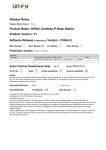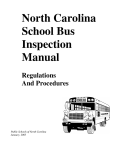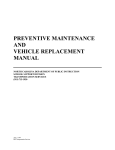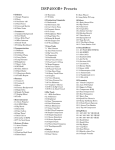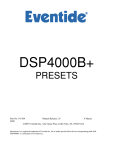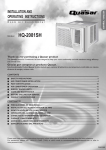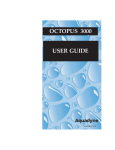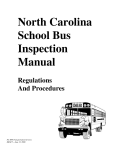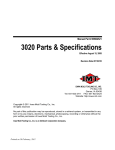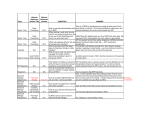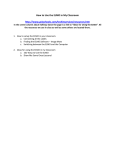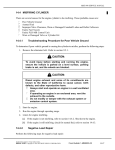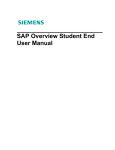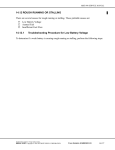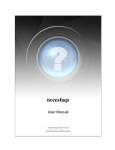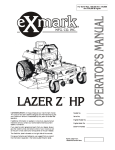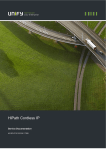Download NC Bus Fleet Manual - NC School Bus Safety Web
Transcript
NC BUS FLEET: North Carolina School Transportation Fleet Manual Preventive Maintenance North Carolina Department of Public Instruction School Support Division, Transportation Services 6319 Mail Service Center, Raleigh, NC 27699-6319 Phone 919-807-3570 • Fax 919-807-3578 www.ncbussafety.org North Carolina State Board of Education Policy EEO-H-005 1 Adopted March 3, 2011 Table of Contents INTRODUCTION ................................................................................................................................... 3 PREVENTIVE MAINTENANCE PROCEDURES ................................................................................... 6 Scheduling ................................................................................................................................. 8 Preventive Maintenance Plans ................................................................................................... 9 PM Due Packaging ....................................................................................................... 11 PM Task List............................................................................................................................. 11 Freightliner 2001 and newer ......................................................................................... 11 IHC 2001 and newer ..................................................................................................... 13 Generic Bus Plans ........................................................................................................ 14 Medium Duty Trucks ..................................................................................................... 15 Light Duty Cars/Trucks.................................................................................................. 16 OFFICE PROCEDURES...................................................................................................................... 17 Required Maintenance Record Documentation ........................................................................ 17 Filing ........................................................................................................................................ 17 Data Entry Procedures ............................................................................................................. 18 Maintenance Activity Types .......................................................................................... 19 Cause Codes ................................................................................................................ 19 Transportation Records Disposal.............................................................................................. 21 BUS GARAGE PROCEDURES........................................................................................................... 23 Fleet Assignments and Management ....................................................................................... 23 Selected Repair Guidelines ...................................................................................................... 24 Regular Maintenance and Related Information......................................................................... 25 Service Vehicle Maintenance and Operation ............................................................................ 26 Vehicle Body Repair & Repainting............................................................................................ 26 Utilization of Surplus Equipment ............................................................................................... 26 Sale of All Other Surplus Items................................................................................................. 27 Discarded Materials, Equipment & Supplies.................................................................. 27 APPENDIX C – State Laws and Policies.............................................................................................. 28 PUBLIC SCHOOL LAW G.S. 115C-248 and 115C-317 .......................................................... 28 APPENDIX G ....................................................................................................................................... 29 Sample Forms .......................................................................................................................... 29 North Carolina State Board of Education Policy EEO-H-005 2 Adopted March 3, 2011 INTRODUCTION North Carolina school children deserve the safest transportation possible. A well-maintained school bus driven by a well-trained professional bus driver helps ensure their safety. The state’s fleet of school buses is kept safe through the work and dedication of thousands of employees of local education agencies (LEAs). The North Carolina Department of Public Instruction (DPI) Transportation Services section works in partnership with these LEAs, providing consultation on school bus transportation and administering the resources needed for school bus operations. This manual provides requirements and guidance related to the fleet of school buses and service vehicles. It includes: Vehicle Purchase, Replacement and Disposal Preventive Maintenance Vehicle Inspection Vehicles The State Board of Education is given statutory authority to fund public school transportation operations and the replacement of vehicles. Specifically, it is the responsibility of the State Board of Education to periodically "...adopt such rules and regulations with reference to the construction, equipment, color, and maintenance of school buses. No school bus shall be operated for the transportation of pupils unless such bus is constructed and maintained as presented in such regulations." North Carolina General Statute 115C-240(c) The statute assures that public school buses throughout the State are built to the same standards and are uniform in appearance. DPI Transportation Services works in partnership with the Department of Administration, Division of Purchase and Contract, to establish a statewide term contract for vehicles meeting the specifications developed by a statewide Vehicle Specifications Committee. At any time, the latest version of this document standardizes the construction and equipment to be included on North Carolina school buses. This authority does not extend to private contractors that may provide school bus transportation to a local LEA. School buses operated by private contractors should meet all federal motor vehicle safety standards (FMVSS’s) applicable to school buses. Similarly, school buses and activity buses owned by an LEA which are not subject to state replacement must also meet all FMVSS’s for school buses or multi-function school activity buses. The purchase of an initial school bus or service vehicle is the responsibility of the LEA. These vehicles are then replaced at state expense after having reached specified mileage or time criteria. In order to be eligible for state replacement, a vehicle must be used only for purposes allowed by general statute and must be maintained as prescribed in this manual. Funds generated from the sale of surplus vehicles are returned to the state fund used to purchase new (replacement) vehicles. Because the State is responsible for replacing school buses, no school bus is to be altered in appearance, color, lettering, or equipment unless authorized by the Department of Public Instruction, Transportation Services Section. In general, items that are included in subsequent year specifications may be retrofitted to older model buses. Additional equipment may be added to school buses as described in the "Alterations and Modifications to School Buses” of this manual. It is important that the installation of new equipment or alteration of appearance be coordinated through and approved by DPI Transportation Services to ensure the integrity and longevity of the fleet. North Carolina State Board of Education Policy EEO-H-005 3 Adopted March 3, 2011 Preventive Maintenance Essential preventive maintenance activities provide a uniform standard necessary to ensure a safe transportation environment for the students in the Public Schools of North Carolina. It is each LEA’s responsibility to maintain school buses as described in this manual. While the maintenance programs presented in this manual represent the minimum requirements for all school buses and service vehicles, more frequent service may be warranted at times. The purpose of the maintenance programs outlined herein is to promote repair consistency and cost efficiency, and to assure that school buses and service vehicles are maintained in safe operating condition. This manual is used in conjunction with the state’s system for fleet management – the Business Systems Information Portal (BSIP), a project of the North Carolina Department of Transportation (NCDOT). BSIP is an online information system through which 100 school bus garages are provided access to their fleet maintenance data. The bus garages share the system with NCDOT and the State Highway Patrol. Data entered by the users are updated in real time and scheduled maintenance activities are reported on a daily basis. The principal areas addressed by BSIP are as follows: • • • • Vehicle replacement status and basic identifiers (e.g. warranty date, VIN) Preventive maintenance and inspection scheduling Inventory management for repair parts, fuel and tires Vehicle maintenance and repair costs histories Timely updating of fleet maintenance data in BSIP is a critical component of proper preventive maintenance. School Bus Inspections North Carolina General Statute 115C-248(a) states the following: “The superintendent of each local school administrative unit, shall cause each school bus owned or operated by such local school administrative unit to be inspected at least once each 30 days during the school year for technical defects or other defects which may affect the safe operation of such bus.” Every 30 calendar days, each school bus (and activity bus) is required to be inspected for mechanical or safety-related defects. This manual outlines a consistent set of items to be inspected on each school bus. Further, criteria that require a bus be placed “out of service until repaired” are provided so that each inspector has a consistent process by which to assess a bus during the inspection. Effective August 1, 2011, LEAs shall require each 30-day inspection required under G.S. 115C-248 to be conducted by an individual who has completed the training and certification requirements administered by the Department of Public Instruction. (State Board of Education Policy TCS-H-011). North Carolina State Board of Education Policy EEO-H-005 4 Adopted March 3, 2011 The success of this maintenance program will be assured through the cooperation of all LEA transportation employees. Assignment of personnel to the prescribed duties listed in this manual is essential in order for the preventive maintenance program to function properly and to be cost efficient. The prescribed school bus garage operational procedures should be followed as closely as possible. While state funds are allocated for the replacement and maintenance of school buses, it is the responsibility of the LEA to provide facilities and equipment. This is outlined in General Statute 115C249 (Purchase and Maintenance of School Buses). Section (e) reads as follows: "It shall be the duty of the county board of education to provide adequate buildings and equipment for the storage and maintenance of all school buses and service vehicles owned or operated by the board of education of any local school administrative unit in such county. It shall be the duty of the tax-levying authorities of such county to provide in its capital outlay budget for the construction or acquisition of such buildings and equipment as may be required for this purpose." Additional information concerning NC school bus transportation can be obtained online at www.ncbussafety.org. Questions regarding the contents of this manual should be directed to DPI Transportation Services at 919.807.3570 (www.ncbussafety.org/contact.html). North Carolina State Board of Education Policy EEO-H-005 5 Adopted March 3, 2011 PREVENTIVE MAINTENANCE PROCEDURES PM MANUAL COMMITTEE MEMBERS The preparation of this preventative maintenance section was a cooperative effort between LEA representatives and NCDPI. The committee would like to thank those around the state that provided input and feedback during the preparation of this manual. The members of this committee were selected as representatives from the nine NCPTA districts of the state. District 1 Rick Stiles (Haywood) District 2 Alfred Schrum (Lincoln) Kenny Warlick (Cleveland) District 3 Donnie Rose (Yadkin) District 4 Al Smith (Alamance) District 5 Jeff Garmon (Cabarrus) District 6 Bill Winstead (Wilson) District 7 Shannon Ennis (Johnston) District 8 David Twiddy (Dare) District 9 Wade Tyndall (Lenoir) NCDPI James Hawkins (Eastern) – PM Committee Chair NCDPI Charles Ball (Central) NCDPI Randy Henson (Western) Ex officio members: NCDPI - Derek Graham – Section Chief NCDPI - Craig Warren – Consultant North Carolina State Board of Education Policy EEO-H-005 6 Adopted March 3, 2011 Preventive Maintenance Overview The following program must be documented by proper completion of all currently required preventive maintenance forms. Documentation of maintenance is essential to conducting an effective, safe and cost-efficient maintenance program and in justifying budget needs and allocations. The key operational factor upon which this PM program is based is vehicle mileage since the last recorded preventive maintenance service. Therefore, accurate odometer operation and mileage recordings are essential as well as accurate record-keeping of all routine daily records. The performance of this maintenance program must be in accordance with all safety rules and regulations prescribed by the Occupational, Safety and Health Administration, the State Board of Education, and the local education agency. All brake repairs shall be checked for operating safety and efficiency by using a Tapley Brake Meter or equivalent meter. The percent of brake efficiency shall be recorded for future reference. Each mechanic should be provided a copy of the Preventive Maintenance Manual. For pre-2007 engines, 15W40, CI-4 / CI-4+ engine oil, or current manufacturer recommendations, SHALL BE USED IN ALL DIESEL engines. Gasoline service vehicles should use the manufacturer recommended oil. This vehicle service is to be recorded on a BSIP-generated DP02 Repair Order by the technician performing the service. This form is to be turned in daily to the appropriate person. Factors that affect oil contamination are as follows: 1. Cold running engine (use at least 185 degree thermostat) 2. Faulty air filtration system 3. Poor operating engine (rich fuel mixture) 4. Weather conditions Oil Analysis - A proper oil analysis program allows technicians to make more informed maintenance decisions. The timely equipment condition information provided through oil analysis results can help users decrease maintenance expenses through component life extension, extended oil drains, and breakdown avoidance. A garage should keep a large supply of Oil Analysis Kits on hand. Always use recommended procedures when drawing an oil sample in order to ensure accurate results. A copy of the analysis results should be kept in the PM file of the particular bus sampled. If analysis results require that oil be changed, a DP01 work order should be generated under the heading BUS # (Mileage) Unscheduled Oil Change per sample results. Access to service and maintenance manuals is required to be available at each school bus garage for each year model vehicle. The manuals, CD or website will be made available by the bus manufacturer. North Carolina State Board of Education Policy EEO-H-005 7 Adopted March 3, 2011 Scheduling The transportation director or other designated employee shall review BSIP screen ZIP24 (Select variant DPI_ PM) each workday morning. The daily work schedule should be adjusted accordingly dependant upon what vehicles are displayed. One advantage of reviewing the screen daily is that it allows each county to service all vehicles before they exceed the preventive maintenance mileage maximum of the specific maintenance plan for the bus. Early Display - All vehicles will appear for preventive maintenance 900 miles before they reach the maximum mileage allowed between preventive maintenance services. Vehicles due 30-day inspections will appear ten (10) days before they exceed the maximum days allowed between inspections. During the school year, each school bus and activity bus must be inspected each thirty-calendar day period to meet state statutes. NOTE: BSIP will continue to count days over an extended holiday period. Goals – The primary goal is to perform each scheduled inspection and preventive maintenance activity on time for each vehicle. BSIP provides notification prior to the due-mileage of a PM. A 900 mile window ensures preventive maintenance service can be performed before the scheduled due-mileage for each bus is reached. BSIP also provides a 10-day advance notification prior to the due date of a 30-day inspection. Vehicles Displayed - Only active vehicles that are being used should appear on the ZIP24 Screen. For sale, sold or cannibalized vehicles should be reported to the BSIP helpdesk for removal. The help desk will also deactivate the plans for local vehicles (other than activity buses) upon request. Factors - The preventive maintenance program is supported by an automated scheduling system. The computer system schedules vehicles for preventive maintenance based on mileage that has been entered into BSIP through fuel entry or work orders. Preventive Maintenance Scheduling - PMs are scheduled at intervals determined by the PM Plan. Scheduled Packaging determines what interval to be scheduled. Please note that PERFORMING PMs EARLY or LATE WILL NOT AFFECT THE SCHEDULE OF THE NEXT PM Screen Display – A screen shot of the ZIP24, variant DPI_PM is shown below: PMs due in order of mileage North Carolina State Board of Education Policy EEO-H-005 8 Adopted March 3, 2011 Preventive Maintenance Plans Technicians should refer to OEM service maintenance manuals for specific preventive maintenance procedures. New Vehicle Service The success of any preventive maintenance program is determined by a number of factors. One of the initial factors, and possibly one of the most important, is the proper servicing of new vehicles prior to placing them into daily service. Without proper new vehicle servicing, the durability, service, and vehicle life will be adversely affected. The following section is devoted to explaining what is required in the proper service of new vehicles and how to correctly accomplish this required New Vehicle Service Refer to the New Vehicle Service Work Order. The mechanic shall complete the New Vehicle Service Work Order during the new vehicle preventive maintenance service prior to the bus being placed in service. This order is created in BSIP for new vehicles and can be accessed via IW38 with an order type of DP07. The information requested for each item shall be completed. After the inspection is finished, the form shall be reviewed by the shop foreman/transportation director and filed in the Individual Vehicle Maintenance History file along with mechanic's signature and entered in the computer. A sample of the New Vehicle Service Work Order is shown below. NOTE: The mechanic is required to initial each service as it is performed as well as record all test results indicated on the new vehicle service work order NEW VEHICLE SERVICE WORK ORDER NOTE: Torque values for any bolt not specified in the vehicle service manual should be obtained from a bolt chart specifying torque . FRONT AXLE ________ Inspect and torque: steering gear mounting bolts and gear case bolts ________ Inspect and torque: pitman arm nut ___________ ft. lbs. ________ Inspect and torque: tie rod, drag link nuts, tie-rod clamp bolts, and/or 3rd arm mounting nut ________ Inspect and torque: backing plate or spider mounting bolts ________ Inspect and torque: front spring u-bolts __________ ft. lbs. ________ Inspect and torque: spring shackle and eye bolts or spring pivot bolts ________ Inspect and torque: king pin lock bolt nuts ________ Inspect and torque: wheel bolts __________ ft. lbs. ________ Check steering shaft u-joints for free movement and trunion snap rings for seating ________ Check and set toe-in ________ Set Axle Stops for Wheels ________ Bar test wheel bearing, Adjust if needed, Check Fluid Level, Use Synthetic fluid if needed REAR AXLE ________ Inspect and torque: spring u-bolts ___________ ft. lbs. ________ Inspect and torque: backing plate or spider mounting bolts ________ Inspect and torque: spring shackles, eye bolts, or spring pivot bolts ________ Inspect and torque: differential to axle housing and inspection cover to axle housing bolts ________ Inspect and torque: axle bolts ______________ ft. lbs. ________ Inspect and torque: wheel bolts ______________ ft. lbs. ________ Bar test wheel bearing, Adjust if needed North Carolina State Board of Education Policy EEO-H-005 9 Adopted March 3, 2011 UNDERCARRIAGE ________ Inspect and torque: Body mounting bolts ________ Inspect and torque: Frame fastener bolts ________ Inspect and torque: U-joint nut and drive shaft center bearing bracket bolts ________ Inspect and torque: Hose clamps and pipe fittings for air lines, air dryer, and tanks ________ Inspect and torque: Bolts in transmission case and transmission mounting bolts ________ Inspect and adjust: Brake chambers push rod to slack adjuster angle; If needed, refer to OEM Service manual for correct adjustment. ________ Inspect routing and mounting of hose, pipes, battery cables, and wiring; Be observant for areas where any of the items may become worn by rubbing or damaged by vibration. Make appropriate corrections or repairs. Other Miscellaneous ________ Pressure test cooling system, visual inspection ________ Test Engine DCA levels ________ Lubricate all fittings ________ Check all fluid levels ________ Adjust headlamps ________ Equip with tire chains (if needed) ________ Perform NC Motor Vehicle Inspection BODY ________ Inspect all lights ________ Adjust door controls and air regulator Door control linkage should be adjusted for the rear leaf of entrance door to close just prior to front leaf. Weather seals should lap against, not butt against each other. ________ Adjust windshield wiper stroke and/or arms ________ Inspect and torque seat mounting bolts, all seat belt mounting and operation ________ Inspect and torque glass channel mounting screws ________ Inspect and torque turn signal bolts and screws, lens screws ________ Adjust mirrors and tighten (check in grid) ________ Inspect all electrical connections in body electrical panel; for proper assembly and tightness. ________ Inspect and torque: body to cowl bolts ________ Inspect and torque: stop sign mounting screws; align and tighten blade mounting bolts ________ Inspect and adjust brake pedal free travel ________ Lubricate glass channels & latches with silicone (including emergency exits) ________ Lubricate drivers seat tracts ELECTRICAL SYSTEM ________ Test starter current draw ________ Amps ________ Volts ________ Alternator output test (regulated) __________ Amps ________ Voltage regular test _______ volts ENGINE ________ Inspect routing of heater hose, install support brackets if needed, tighten clamps ________ Inspect and torque: oil pan, valve cover and rocker arm cover bolts ________ Inspect and torque: manifold and exhaust pipe bolts and nuts ________ Inspect all electrical connections ________ Inspect throttle controls ________ Inspect/Adjust engine accessory drive belts North Carolina State Board of Education Policy EEO-H-005 10 Adopted March 3, 2011 ROAD TEST ________ Check travel angle ________ Check steering gear operation (lock to lock), lost motion, shimmy ________ Check rear axle and drive line noise ________ Check transmission: operation, noise ________ Automatic shift points up 1-2 ____ 2-3______ 3-4 ____ (WOT) ________ Automatic shift points down 4-2 _____ 2-1 ______ ________ Test for maximum mph ______ top speed ________ Break meter test _______ % (Brake meter min. 60%) AFTER ROAD TEST ________ Adjust lubricant level in transmission and differential ________ Park vehicle in a clean dry area, observe 5 min. later for leaks ________ Property complete a TD-30 ________ Clean Bus: remove metal shavings, loose screws, stickers, etc. PM Due Packaging Due Packaging Description 5K 5,000-Mile Preventive Maintenance Service 5K10K 10,000-Mile Preventive Maintenance Service 5K10K15K 15,000-Mile Preventive Maintenance Service 5K10K15K20K 20,000-Mile Preventive Maintenance Service 5K10K15K20K30K 30,000-Mile Preventive Maintenance Service 5K10K15K20K30K60K 60,000-Mile Preventive Maintenance Service 5K10K15K20K30K60K90K 90,000-Mile Preventive Maintenance Service PM Task List The PM task list consist of the operations that need to be completed for each PM. BSIP will track and generate the task list for each set of buses based on mileage and the plan that is assigned to the particular bus. Most of the tasks have been taken from manufacturer’s service recommendations. It is extremely important for each mechanic to become familiar with these manuals. If it is questionable on how the operation should be performed, this manual should be reviewed to ensure the correct service as prescribed by the manufacturer. One manual is usually sent with each bus. Freightliner 2001 and newer 5000 Mile Intervals Lube all fittings (007) Oil sample if 0205 not done Lube door/hood hinges and latches (007) Bus pickup/travel time North Carolina State Board of Education Policy EEO-H-005 11 Adopted March 3, 2011 10000 Mile Intervals Inspect engine drive belt (006) Check Eaton viscous fan drive (006) Check radiator cap (006) Replace outer air cleaner element (006) Insp/lube window latches/tracks (006) Insp/adj door latches/fasteners (006) Check alternator, battery, starter (006) Check and clean ground cables (006) Check electrical wiring (006) Check transmission breather (006) Inspect air dryer (006) Insp/clean air reservoir auto drain(006) Inspect exhaust system (006) Service wheel chair lift (006) Insp/record brake lining thickness (006) Record trans. shift points (006) Road test-record brake panic stop (006) 15000 Mile Intervals Change engine oil and filters Change oil by-pass filters (003) Change fuel filters (003) Inspect engine and components (006) Inspect cooling system (006) Check coolant concentration/PH: (006) Wash eng/battery comp/axles/slacks(002) 30000 Mile Intervals Check engine support fastener (006) Pres flush rad & change coolant (002) Change trans spin-on filter (003) Insp seat frames for cracks/mount (006) Check frame fastener torque (006) Check springs u-bolt torque (001) Chk spr brake fastener torque-rear (006) Check air bag fastener torque (001) Chk suspension component clearance (006) Insp suspen component & chk oper (006) Check air springs u-bolt torque (006) Check shock absorbers (006) Check radius rod bushing (Hendr) (006) Chk spring fastener torque (Hendr) (006) Clean/repack/adjust wheel bearings (003) Check wheel nut and rim nut (006) Repl air dryer desiccant Ben AD-9 (003) Change pwr str reser fluid/filter (003) Replace inner air cleaner element (006) 60000 Mile Intervals Adjust valves-MBE900 only (001) 90000 Mile Intervals Change diff fluid/clean mag plug (003) Adjust valves-CAT only (001) North Carolina State Board of Education Policy EEO-H-005 12 Adopted March 3, 2011 IHC 2001 and newer 5000 Mile Intervals Lube all fittings (007) Oil sample if 0050 not done Lube door/hood hinges and latches (007) Bus pickup/travel time 10000 Mile Intervals Change engine oil and filters Change engine oil by-pass filter (003) Inspect engine drive belt (006) Check Eaton viscous fan drive (006) Check radiator cap (006) Clean fuel filter pre-strainer (006) Inspect air cleaner assy/piping (006) Inspect/lube window latches/tracks (006) Inspect/adj door fasteners/latches (006) Check alternator, battery, starter (006) Check and clean ground cables (006) Check electrical wiring (006) Check transmission breather (006) Inspect air dryer (006) Insp/clean air reservoir auto drain(006) Inspect exhaust system (006) Service wheel chair lift (006) Insp/record brake lining thickness (006) Road test-record brake panic stop (006) Wash eng/battery comp/axles/slacks(002) 20000 Mile Intervals Change fuel filters (003) Inspect engine and components (006) Inspect cooling system (006) Check coolant concentration/PH: (006) 30000 Mile Intervals Check engine support fastener (006) Pres flush rad & change coolant (002) Change tranmission spin-on filter (003) Insp seat frames for cracks/mount (006) Check frame fastener torque (006) Check springs u-bolt torque (001) Chk spr brake fastener torque-rear (006) Check air bag fastener torque (001) Chk suspension component clearance (006) Insp suspen component & chk oper (006) Check air springs u-bolt torque (006) Check shock absorbers (006) Check radius rod bushing (Hendr) (006) Chk spring fastener torque (Hendr) (006) Clean/repack/adjust wheel bearings (003) Check wheel nut and rim nut (006) Repl air dryer desiccant Ben AD-9 (003) Change pwr str reser fluid/filter (003) North Carolina State Board of Education Policy EEO-H-005 13 Adopted March 3, 2011 60000 Mile Intervals Change air filter element (003) 90000 Mile Intervals Change diff fluid/clean mag plug (003) Generic Bus Plans 5000 Mile Service Perform Oil Sample Lube grease fittings/check fluids (007) Lube door/hood hinges and latches (007) Bus pickup/travel time 15000 Mile Service Wash engine/battery compartment (002) Change oil and filter Replace fuel filters (003) Test and service air filter (006) Check crankshaft end play (006) Clean heater filter (002) Adjust governor/throttle (linkage) (001) Test coolant additive (DCA level) (006) Replace coolant filter (006) Pressure test cooling system (006) Service battery (cable and comp.) (006) Inspect and adjust engine belts (006) Record alternator volt/amp reading (006) Service air comp. (filter/ejector) (006) Replace AT auxiliary filter (003) Test steering gear operation (006) Check spring ubolts (001) Service wheel chair lift (006) Visually inspect front end alignment (001) Check or reline front brakes (006) Turn front brake drums (if needed) (001) Repack front wheel bearings (007) Adjust brakes (001) Bus pickup and delivery (020) Brake test (panic stop reading) (006) Road test (018) Change auto trans. filter & fluid (007) 30000 Mile Service Check or reline rear brakes (006) Turn rear brake drums (if needed) (001) Bar test rear wheel bearings (007) Inspect S-cam bushings (006) North Carolina State Board of Education Policy EEO-H-005 14 Adopted March 3, 2011 60000 Mile Service Tune engine, Adjust Valves OEM SP (006) Change power steering fluid & filter Change air dryer element (007) Drain/rep. brake fluid (hydraulic) (007) Change differential fluid(007) Drain/flush radiator (002) Remove and inspect all wheel bearings Undercoat bus (015) Medium Duty Trucks 5000 Mile Service Perform oil sample Lube grease fittings/check fluids (007) Lube door/hood hinges and latches (007) Service battery (cable and comp.) (006) 15000 Mile Service Change oil and filter Replace fuel filters (003) Test and service air filter (006) Check crankshaft end play (006) Clean heater filter (002) Test coolant additive (DCA level) (006) Replace coolant filter (006) Pressure test cooling system (006) Inspect and adjust engine belts (006) Record alternator Amp/Volt reading (006) Service air comp. (filter/ejector) (006) Replace AT auxiliary filter (003) Test steering gear operation (006) Check spring ubolts (001) Check front end alignment (toe in) (001) Check or reline front brakes (006) Turn front brake drums (if needed) (001) Repack front wheel bearings (007) Check brake adjustment (001) Road test (018) Change Auto trans. Filter & fluid (007) 30000 Mile Service Wash eng/bat compart -Low Pressure (002) Check or reline rear brakes (006) Turn rear brake drums (if needed) (001) Bar test rear wheel bearings (007) Inspect S-cam bushings (006) Check tension belt pulley (006) North Carolina State Board of Education Policy EEO-H-005 15 Adopted March 3, 2011 Light Duty Cars/Trucks 5000 Mile Service Change oil and filter Lube grease fittings/check fluids (007) Lube door/hood hinges and latches (007) Service battery (cable and comp.) (006) Rotate Tires Ck. Brake lining, reline as necessary Repack wheel bearings when brakes relined 15000 Mile Service Replace fuel filters (003) Test and service air filter (006) Pressure test cooling system (006) Inspect and adjust engine belts (006) Record alternator Amp/Volt reading (006) Test steering gear operation (006) Check or reline front brakes (006) Turn front brake drums (if needed) (001) Repack front wheel bearings (007) Road test (018) 30000 Mile Service Wash eng/bat compart -Low Pressure (002) Change auto trans. fluid & filter (007) Check or reline rear brakes (006) Turn rear brake drums (if needed) (001) Repack rear wheel bearings (007) Check tension belt pulley (006) Test starter/rec. amp/volt reading (006) Visually Check all steering linkages Visually Check front end alignment Check spring u-bolts 60000 Mile Service Tune up engine (006) Change power steering fluid & filter (006) Drain/rep. brake fluid (hydraulic) (007) Change differential fluid (007) Drain/flush/change radiator (002) 90000 Mile Service Adj. engine valves per service manual (001) Remove & inspect wheel brngs (006) Change Manual Transmission Fluid North Carolina State Board of Education Policy EEO-H-005 16 Adopted March 3, 2011 OFFICE PROCEDURES Required Maintenance Record Documentation The following are maintenance record forms and other related documents, which are required to manage and document the school vehicle maintenance program. These forms are to be properly and thoroughly completed and filed appropriately. DPI Transportation Services staff members will review these records during the annual inspection and other times as needed. Occasionally these forms are updated to accommodate changing needs, however, sample forms have been provided in (APPENDIX G). These forms are also available at WWW.NCBUSSAFETY.ORG under the reports & forms section. • • • • • • • TD-18A – Equipment Repair and Parts Order TD-18B – Fuel and Lubricant Issue Ticket TD-21 – Inventory Receipt (ME21N) TD-27 – Spare Vehicle Assignment Log TD-28D – Bus Driver Sign-In Sheet TD-28R – Reported Defects Log TD-28S – Service Call Log Filing All of the file folders listed in this section are essential for proper documentation of your vehicle maintenance program. An explanation of each folder listed below is presented in following sections. Individual Vehicle History File – The Individual Vehicle History file should contain information that should be kept for the life of the vehicle. Examples include: 1. 2. 3. 4. 5. 6. Line Setting Sheets Warranty Information Vehicle recall documentation Major repair (warranty and non-warranty) documentation Major damage documentation (e.g. flood, fire, crash) Other information deemed necessary by the LEA Individual Vehicle Inspection File - The Individual Vehicle Inspection file should include all monthly inspections. The Inspections should be filed with the most current record filed in the front of the file. Individual Vehicle Preventive Maintenance (PM) File - The Individual Vehicle Maintenance file should include all completed preventive maintenance work orders. The maintenance orders should be filed with the most current record filed in the front of the file. Note: A county may elect to combine the Inspection and PM files for each bus, with documents filed chronologically or separated front and back with, for example, PM’s in the front and Inspections in the rear. Individual Vehicle Repair Order File - The Individual Vehicle Repair Order file should include all complete repair orders. The Orders should be filed with the most current record filed in the front of the file. North Carolina State Board of Education Policy EEO-H-005 17 Adopted March 3, 2011 Individual Vehicle Work Order (TD-18) File - The Individual Vehicle Work Order file should include all incomplete work orders. The file should be reviewed when a vehicle comes to the shop and the work orders should be completed while the vehicle is in the shop. (NOTE: the shop foreman or personnel responsible to manage the maintenance of the vehicles usually maintain this file) Vehicle Accident File - The Vehicle Accident File should include all accident reports. The Accident Reports should be filed so that they can be easily located by date and by vehicle. Discarded Equipment File – This file should include documentation of all equipment sold (surplus buses and trucks, scrap metal, scrap tires. For vehicle sales, it is useful to include a copy of the payment check and vehicle title and retain that copy in this file. Inventory Received file – Because of the variety of invoices received (unit pricing, total pricing, tax, freight, etc.) it is essential that proper pricing of individual items received in inventory be calculated prior to entry in BSIP. The TD-21 worksheet (paper or electronic) helps to facilitate proper data entry. Calculations or inventory receipts should be retained in paper or electronic (spreadsheet) files. Fuel Issues File – A chronological file of all paperwork associated with issuing fuel from the fueling station or from fuel trucks must be maintained. School Bus Driver Sign-in Sheet – A system through which school bus drivers can report vehicle defects on a daily basis is a critical part of proper maintenance. Hard copy forms containing the key information required on the TD-28 (Bus Driver Sign-in Sheet) must be maintained. Original files must be available at the LEA transportation office. Service Call Logs – A system for logging incoming emergency maintenance calls (breakdowns) must be in place. Hard copy or electronic forms containing the key information required on the TD-17 Form (Service Call Log) must be available at the LEA transportation office. E-Mail Communications – Regular communication from the Department of Public Instruction is sent to school transportation employees via an email list. Critical messages are assigned a numerical reference – for example, “DPI Message # 117 – Transportation Allotments Increased.” E-mail messages with DPI Message Numbers should be filed together in numerical order for future reference and to help prevent missed messages. Data Entry Procedures Entering maintenance data in BSIP is required to ensure proper documentation of required maintenance, labor charges and parts assignments. Because of the impact on vehicle mileage documentation, fuel issues should be entered in the system first. Following fuel issues, vehicle inspections should be entered, followed by preventive maintenance and, finally, “TD-18” maintenance work orders and inventory receipts. North Carolina State Board of Education Policy EEO-H-005 18 Adopted March 3, 2011 Maintenance Activity Types BSIP requires activity types to be associated with each work order. The following table indicates the different activity types and the kind of work order that should be coded to each. Code 2 Description Recall, Safety 3 Recall, Other 4 Emergency 5 Inspections 7 Scheduled Correction 12 Warranty 14 Wreck Repair Examples Any recall that is related to a safety issue. Examples: brake valve recall, handrail recall, All other recalls not related to a safety issue. Examples: roof hatch leak recalls, etc. All unscheduled repairs of a vehicle Examples: road calls, wrecker call, repairs at school, Repairs at shop that are not scheduled. All Inspections Examples: 30 day inspections, annual DMV Inspection Any vehicle that is on a schedule for repairs. Examples: All PM,s, a bus that is scheduled to have an engine replaced. A bus that is scheduled to have the brakes replaced prior to the brakes failing, a bus scheduled to be painted, a bus scheduled to have a wheel alignment. etc. Any repairs made under warranty. Work done at the manufacturer, at the LEA’s shop, by the manufacturer personnel or shop LEA personnel. Any Repairs made due to an accident Cause Codes BSIP allows a code to be associated with the CAUSE of each work order. The following table indicates the different activity types and the kind of work order that should be coded to each. Code 1 Causes Breakdown 2 Consumption, Fuel 3 Consumption, Oil 4 Driver’s Report 5 Routine Inspections North Carolina State Board of Education Policy EEO-H-005 Examples Any unscheduled repairs made due to a breakdown of a component at school or shop. Include only defects found by the technician or reported by anyone other than the driver. Examples: Flat tires, malfunctioning lights, heaters, wipers, horn, broken glass, etc. Any repairs made for the sole purpose of increasing MPG. Examples: Changing the air filter for the sole purpose of increasing MPG. Tune-ups for the sole purpose of increasing MPG. Any repair made for the sole purpose of decreasing oil consumption. Examples: Replacing gaskets or seals on the engine for the sole purpose of reducing oil consumption. Any unscheduled repair made at school or shop that are reported by the driver. Examples: Flat tires, malfunctioning lights, heaters, wipers, horn, broken glass, etc. All monthly inspections (30-Day Inspections) 19 Adopted March 3, 2011 Code 6 7 Causes Lubrication Pre-Delivery 8 All PM’s 9 Rework 10 Road Call 11 Routine 21 Capital Improvement 22 Conversion 23 Modification 24 Special Study 32 Accident, Reported All recalls 33 34 36 37 Statutory Inspection Any Modification Required by law. Theft Vandalism 38 Warranty 39 Natural Causes 41 Abuse of Equipment 35 North Carolina State Board of Education Policy EEO-H-005 Examples Any lubrication outside of PM All new vehicle Prep. All work involved in preparing a vehicle for first time use. All PM’S Examples (05,06,07,08) Any Repairs made to components that were not repaired correctly the first time. Service Call: Any call for service on a route that requires travel to the vehicle before the vehicle can continue on the route; or if the vehicle can not be repaired and has to be towed to shop for repairs. Example: Flat tires, inoperable warning lights, engine malfunction, stuck vehicle on route, vehicles out of fuel on route, etc. Catch -All Use for routine maintenance. Examples: Summer repairs, inflating tires, checking fluids, fueling buses, etc. Addition of any equipment that will increase the value of the vehicle. Example: Addition of an air conditioner, upgraded seats, must be DPI approved additions. Not Used Any approved modifications that will not increase the value of the bus. Examples: Upgrade Crossing Arm, Roof Hatch, Strobe Lights, etc. Any repairs or adjustments to equipment involved in a pilot study or research data study. Any activities due to a reported accident. Examples: Investigation, wrecker service, etc. Repairs made due to safety recall or any other recall. Examples: Repairs made due to safety recalls or any other recalls by request of the manufacture. Annual DMV Inspections Any modification that is required to be made due to a law or code. Example: FMVSS Modification (crossing arm). Any repairs made due the theft of the vehicle. Any repairs made due to the act of vandalism. Examples: Cut seats, broken glass, due to the act of a person cutting or destroying. Any time or repairs associated with a component being repaired under warranty of the vehicle. Any repairs made due to act of nature. Examples: Fallen trees, floods, storm, wind damage, etc. Any repairs due to Driver abuse of equipment. Examples: Twisted drive shafts, broken axles, etc. 20 Adopted March 3, 2011 Transportation Records Disposal The following information is taken from the State of North Carolina Department of Cultural Resources, Division of Historical Resources, Archives and Records Section. Accident Reports and Tort Claims File - Copies of accident reports, plaintiff’s affidavits, and notices of tort claims. (See G.S. §143-300.1) Disposition Instructions: Destroy in office 7 years after settlement of claim. Annual Transportation Reports File - Summary reports listing the activities of a local education agency’s transportation department. Reports include number of days fleet was in operation, total number of miles buses were driven, number of buses operated, salaries paid to drivers and other transportation personnel, number of personnel employed, list of local expenditures, transportation policy questionnaires, inventory data, and other related information. Copies of report are sent to the central office and the Department of Public Instruction. Disposition Instructions: Destroy in office after 3 years. Bus Inspection Reports File - Inspection reports of school buses or school transportation service vehicles. Disposition Instructions: Destroy in office after 3 years. Contract Transportation for Children w/ Disabilities and Other Contracted Services File - Records concerning contracted transportation services for children with disabilities or other pupils, or other groups. File includes contracts, bus driver routes, salary schedules, refund reports, school bus passenger reports, annual transportation reports, inspection reports, and other related records. Disposition Instructions: Destroy in office after 3 years if no litigation, claim, audit, or other official action involving the records has been initiated. If official action has been initiated, destroy in office after completion of action and resolution of issues involved. Cost of Transportation File - Records concerning the operation, maintenance, replacement, and insurance of school buses or other school transportation service vehicles. File includes requisitions, expenditure reports, and other related records. Disposition Instructions: Destroy in office after 3 years and when released from all audits, whichever occurs later. School Bus Inventory and Maintenance File – Fleet maintenance records compiled from the Business Systems Information Portal (BSIP) that concern the maintenance of school buses or school transportation service vehicles. File includes 30-day inspection worksheets, oil filter reports, fuel receipts, preventative maintenance charge tickets, bus fleet inventories, and other related records. Disposition Instructions: Destroy in office after 3 years if no litigation, claim, audit, or other official action involving the records has been initiated. School Bus Routes File - Records concerning routes taken by school buses. File includes descriptions of routes, passenger lists, bus run reports, and other related records. Disposition Instructions: Destroy in office after 3 years. North Carolina State Board of Education Policy EEO-H-005 21 Adopted March 3, 2011 Seat Belt File - Records concerning the use and installation of seat belts and other restraint systems in school buses. File includes consent forms and similar records showing student’s name, bus number, date system requested, type of system requested, and signatures of school’s principal and student’s parent and/or guardian. Disposition Instructions: Destroy in office when superseded or obsolete. State Vehicle Fleet Management System (BSIP) (Electronic) File - BSIP is a electronic data processing record used by the local education agency to track inventory and maintenance of school buses or school transportation service vehicles. Preventative maintenance information and inventories of buses are entered into this electronic file. DISPOSITION INSTRUCTION: General guidelines for disposing of machine readable and electronic data processing records may be found in STANDARD-4. MACHINE READABLE AND ELECTRONIC RECORDS. BSIP inventory and maintenance information should be retained in electronic form for 3 years after applicable inventories and maintenance reports are produced and then erased or deleted. Transportation Information Management System (TIMS) (Electronic) File - TIMS is an electronic data processing record concerning the management of school transportation services. Bus scheduling and routing information, students’ addresses, bus maintenance schedules, mileage of buses, and other related data are entered into this electronic file. Disposition Instructions: General guidelines for disposing of machine readable and electronic data processing records may be found in STANDARD-4. MACHINE READABLE AND ELECTRONIC RECORDS. TIMS data and statistics should be retained in electronic form for 3 years after applicable statistical reports are produced and then erased or deleted. Transportation Records File - Records documenting school bus maintenance and use. File includes number of hours driven, refund and materials received report, and transportation charge. File also includes summaries, reports, transportation audits, and similar records generated by the Transportation Management System (TIMS) and/or received from the N.C. Department of Public Instruction. Disposition Instructions: Destroy in office after 3 years or when superseded, obsolete, or administrative value ends, whichever occurs first. Vehicle Inspections File - Records concerning inspections as required by the Department of Transportation, Division of Motor Vehicles, Enforcement Section. File includes inspection certificates, monthly summary lists, and receipts and statements for vehicle inspection certificates. Disposition Instructions: Transfer original records to the Department of Transportation, Division of Motor Vehicles, Enforcement Section when generated. Destroy duplicates in office after 18 months and when released from all audits, whichever occurs later. North Carolina State Board of Education Policy EEO-H-005 22 Adopted March 3, 2011 BUS GARAGE PROCEDURES Fleet Assignments and Management According to General Statutes 115C-241:246, the LEA superintendent or designee has the responsibility for assigning students to buses, assigning buses to schools, establishing routes, etc. In general, the transportation director is responsible for maintaining a current list of school buses in operation on a daily basis and the assignments of those buses. G.S. 115C-240(d) requires that all LEAs use the Transportation Information Management System (TIMS) or an equivalent system for routing. LEAs are also required to use DOT’s Business Systems Improvement Portal (BSIP) for fleet maintenance. These systems should be maintained on a timely basis to ensure real-time accuracy of fleet assignments and status. Extra Bus Schedule Documentation - When a school bus is not available for regular service due to maintenance or accident, a spare bus may be used in its place. This is the only time that a spare bus may be used. Careful documentation on the allocation of spare buses must be kept, including the location, bus numbers and dates out/in. The TD-27 (Spare Bus Assignment Form) fulfills this requirement. Garage Procedures - Proper garage operation is essential to a cost effective preventive maintenance program. The maintenance programs presented in this manual requires that the operation of the school bus garage be conducted in the manner described below. The following procedures should be utilized at the garage: • The garage shall be kept in a clean, workable, safe condition at all times. • A designated parking area should be available for vehicles awaiting maintenance or repair. • Regularly scheduled maintenance (PM and 30-day inspection) is flagged in BSIP and work orders are automatically generated. When a vehicle is brought to the bus garage for other nonscheduled maintenance, a work order should be initiated in BSIP (or prepared on a hard copy TD-18) and held by the supervisor in charge of maintenance until assigned to a technician. • A technician driving a vehicle at any time should consider it to be a road test. They should always be alert and aware of any defects. Any defects detected shall be reported and added to a repair order. • It is essential for broken odometers to be repaired immediately whenever they are detected as malfunctioning. Correct vehicle mileage is essential for the proper scheduling of the preventive maintenance program by the computer. LEA’s should get a speedometer shop to set new odometer mileage reading to old odometer reading (if possible). North Carolina State Board of Education Policy EEO-H-005 23 Adopted March 3, 2011 Selected Repair Guidelines The following recommendations should supplement the procedures provided by the original equipment manufacturer (OEM): • When performing preventive maintenance on brakes, it is recommended that one person adjust all brakes. • When the brakes are relined, the brake drums shall be turned (if needed) and not to exceed manufacturers drum wear specifications and the wheel cylinders/calipers rebuilt (if needed). The repairing mechanic shall record the brake lining thickness at the thickest point above the rivet head, in the proper place on the work order when performing a major service work order. A tread depth gauge measured in thirty-seconds shall be used to measure rivet depth. • All S-cam shall be checked per OEM specifications. • Automatic transmissions, engines and differentials replaced by stock units and left to be rebuilt later, shall be stored in a designated area and tagged with the number of the bus from which removed and the apparent defects or symptoms. Rebuild all major components and subassemblies to the manufacturers recommended specifications. • The responsibility for maintaining safe tires on school buses (regular and spare) will be assigned by the foreman and/or supervisor. This does not relieve other employees of responsibility. Any employee who detects an unsafe tire (just as any other defect), on any vehicle maintained by the school bus garage, becomes responsible for changing the tire or repairing that defect, or informing the foreman or director that such action is needed. The determining factor of when to change a tire will be when it has worn to the point where the thinnest tread has only 4/32" on steering axle and 2/32" on rear axle of tread depth remaining (radial tires). Proper front-end alignment is essential to cost effective tire life. When installing tires on vehicles, new tires are required to be installed on the front axle. Rear duel tires shall be matched for size to within a maximum of 1/4" diameter of each other if possible. New tires are required on the front axle of all school buses. • All tires and wheels to be repaired should be washed (weather permitting) before being taken to the tire shop. • All new tires and newly delivered recap tires should be balanced after mounting and before being placed on a vehicle or in the storage rack. • Used batteries shall be washed and cleaned properly prior to placing in the battery room (or designated area) for recharging or storage. A ventilated location is required to recharge batteries. • As needed, add antifreeze that meets OEM specifications to the cooling system of each bus. Antifreeze protection should be maintained according to OEM recommendation. (50/50 Mixture) • Engine coolant DCA level test kits shall be used to determine if maintenance of the cooling system is needed. • Perform the annual North Carolina motor vehicle inspection required by G.S. 20-183.3(a) and attach the proper sticker to the assigned windshield location. This is may be performed only by certified N.C. inspectors at approved garages. North Carolina State Board of Education Policy EEO-H-005 24 Adopted March 3, 2011 Personnel Utilization An important factor in the effectiveness of a preventive maintenance program is the ability and willingness of all transportation personnel to work together with one goal in mind: a cost efficient and safe preventive maintenance program. The assignment of personnel to specific daily job duties is essential for the preventive maintenance program presented in this manual to be successful. Regular Maintenance and Related Information In general, maintenance activities are categorized as scheduled or unscheduled. Schedule maintenance activities include all preventive maintenance (PM) and 30-day inspections. Unscheduled maintenance is usually initiated by a defect found during the inspection or results from a report from the driver. Reporting of defects by drivers: • Bus Drivers are required to sign in each day where the bus is parked (e.g. using form TD-28D) to report any defect or problem detected during the pre-trip/post-trip inspection or identified while the bus was running. • Immediately upon arrival of all buses, a designated person should call, fax or e-mail the bus garage giving a report of mechanical problems on the TD-28D (bus driver sign in) form. Other processes may be used; however, all reported problems shall be addressed on a daily basis. • The transportation director shall assure that a process is in place to address reported defects and make needed repairs. • In the event critical repairs cannot be made before the bus needs to run again, a spare bus should be assigned to run in its place. • Personnel assigned to repair problems reported on the TD-28D shall turn in the list of defects with notation and corrections along with the TD-18 repair order. • The foreman and/or director should check the repair order against the TD-28D form. Typically, basic maintenance, fueling and observations are conducted during the day at the bus parking area (bus lot, bus garage or school) and more involved maintenance activities are conducted at the bus garage. Depending on the LEA, these tasks may be conducted by fuel truck drivers or technicians, as assigned by the transportation director. • • • • • • • • Fuel vehicles according to a regular schedule (fuel dispensed must be charged to the nearest tenth of a gallon on form TD-18B Fuel Issue Ticket) Obtain odometer readings for each vehicle fueled Check oil, water, tires and under-hood observation Analyze and repair defects or problems reported by bus drivers each day Perform 30-day inspections prior to scheduled due-date Perform scheduled preventive maintenance prior to scheduled due-mileage Perform unscheduled maintenance Perform other maintenance tasks assigned by the transportation director / supervisor The transportation director should ensure that staff know proper safety procedures to be followed when conducting maintenance procedures. For instance, any time someone is working under a bus, chock blocks are to be used. North Carolina State Board of Education Policy EEO-H-005 25 Adopted March 3, 2011 Service Vehicle Maintenance and Operation The transportation director is responsible for the proper use, care and maintenance of all school garage service vehicles. This includes pickup trucks (or vans), fuel dispensing trucks, tire trucks, and wreckers. All service vehicles are recommended to be inspected each 30 days in the same manner as school buses and activity buses and annually in accordance with the Division of Motor Vehicles regulation G. S. 20-183.3(a). All school garage service vehicles are to be maintained in good operating condition and in a safe state of repair. Interior upholstery must be maintained for the safety and comfort of the driver. (Seat cover cannot be ripped, torn or holes worn through.) Body repair and repainting of service vehicles should be conducted as needed and service vehicles should be cleaned inside and out at least once a month. Vehicle Body Repair & Repainting While the appearance of school buses and service vehicles may not always directly affect safety, it does affect the public’s perception of the safety and mechanical condition of the school bus fleet. Driver attitudes and care of their assigned vehicles are influenced considerably by the appearance of those vehicles. Vehicles shall be repaired and repainted as needed. If a county does not have in-house painting facilities, contracted painting should be used. Utilization of Surplus Equipment In some cases, rather than being sold, a bus may be classified as salvage by DPI Transportation Services. With the approval of the regional area transportation consultant, parts may be used from school buses which have been identified for salvage. Parts cannot be removed from any route bus (E2RB,RC,RR,LC), spare bus (ESS), parked bus (ESP), for sale bus (E4), credit bus (E0B), OR sold bus (E6) under any circumstances. PARTS CAN ONLY BE REMOVED FROM SALVAGE (STATUS EZ) BUSES. Parts removed from other vehicles without proper authorization shall be reinstalled by the school bus garage staff. To obtain a listing of salvage buses, utilize BSIP screen IE36. Select a variant, such as DPI_EZ, that will select Status Included = EZ and Fleet Object Type 6000. Permission to use major components (Engine, transmission, differential) must be requested prior to installation on a regular bus. Contact a DPI area transportation consultant for the procedures required to utilize major components from a salvage vehicle. North Carolina State Board of Education Policy EEO-H-005 26 Adopted March 3, 2011 Sale of All Other Surplus Items Sale of all other surplus items generates revenue for the replacement of service vehicles or is returned to the LEA. Proper procedures must be followed and paperwork submitted using the appropriate form. (See APPENDIX G). Surplus Sale Forms (Available at NCBUSSAFETY.ORG) 1. TD-6B – Bus Sale Form 2. TD-6M – Local Scrap Metal Sale Form 3. TD-6T – Scrap Tire Pickup Form Discarded Materials, Equipment & Supplies Obsolete Parts and Scrap Metal - Obsolete parts (those that cannot be returned to the vendor) and scrap metal may be sold through State Surplus Property or locally. Following are three options related to this activity. 1. Contact your DPI field consultant to write up a lot of surplus parts or scrap metal for sale through state surplus. Revenue goes into the service truck replacement fund. 2. Include these surplus items in a local sale conducted by the school system. Revenue goes to the LEA. A detailed list including inventory numbers and quantities must be generated in order to remove the inventory from BSIP and report on TD-1. Other documentation must be mailed or emailed to DPI Transportation Services. 3. If you have access to a scrap metal dealer, scrap metal may be sold directly. Notify your DPI field consultant of this activity. The check must be made out from the dealer to the Department of Public Instruction. Revenue goes into the service truck replacement fund. Scrap Tire Casings - 130A-309.09A. Local government solid waste responsibilities. (a) “…Each unit of local government shall implement programs and take other actions that it determines are necessary to address deficiencies in service or capacity required to meet local needs and to protect human health and the environment….” Options for these casings are as follows: 1. Send the casings to be recapped to be used again on school buses. 2. Declare the casings to be scrap and contact the State Surplus contractor to pick up the scrap tires. Revenue goes to the service truck replacement fund. If you have more casings than you need, you many determine that those casings still have value. State law permits several types of sales. 1. Contact your DPI field consultant to write up a lot of tires for sale through state surplus. Revenue goes to the service truck replacement fund. 2. Return the casings to a vendor with which your LEA does business in exchange for fair market value and receive a credit to your account. All such transactions must be documented and retained in files for inspection by local auditors and DPI consultants. Provided the original tire was purchased with state funds, transfer the casings to another county school bus garage for the purpose of being recapped. This may only be done with the written approval of a DPI Transportation Services staff member. A copy of the approval must be maintained in the files documenting the transaction. North Carolina State Board of Education Policy EEO-H-005 27 Adopted March 3, 2011 APPENDIX C – State Laws and Policies PUBLIC SCHOOL LAW G.S. 115C-248 and 115C-317 § 115C-248. Inspection of school buses and activity buses; report of defects by drivers; discontinuing use until defects remedied. (a)The superintendent of each local school administrative unit, shall cause each school bus owned or operated by such local school administrative unit to be inspected at least once each 30 days during the school year for mechanical defects, or other defects which may affect the safe operation of such bus. A report of such inspection, together with the recommendations of the person making the inspection, shall be filed promptly in the office of the superintendent of such local school administrative unit, and a copy thereof shall be forwarded to the principal of the school to which such bus is assigned. (b) It shall be the duty of the driver of each school bus to report promptly to the principal of the school, to which such bus is assigned, any mechanical defect or other defect which may affect the safe operation of the bus when such defect comes to the attention of the driver, and the principal shall thereupon report such defect to the superintendent of the local school administrative unit. It shall be the duty of the superintendent of the local school administrative unit to cause any and all such defects to be corrected promptly. (c) If any school bus is found by the principal of the school, to which it is assigned, or by the superintendent of the local school administrative unit, to be so defective that the bus may not be operated with reasonable safety, it shall be the duty of such principal or superintendent to cause the use of such bus to be discontinued until such defect is remedied, in which event the principal of the school, to which such bus is assigned, may permit the use of a different bus assigned to such school in the transportation of the pupils and employees assigned to the bus found to be defective. (d) The superintendent of each local school administrative unit, shall cause each activity bus which is used for the transportation of students by such local school administrative unit or any public school system therein to be inspected for mechanical defects, or other defects which may affect the safe operation of such activity bus, at the same time and in the same way and manner as the regular public school buses for the normal transportation of public school pupils are inspected. A report of such inspection, together with the recommendations of the person making the inspection, shall be filed with the principal of the school which uses and operates such activity bus and a copy shall be forwarded to the superintendent of the local school administrative unit involved. It shall be the duty of the driver of each activity bus to make the same reports to the principal of the school using and operating such activity bus as is required by this section. If any public school activity bus is found to be so defective that the activity bus may not be operated with reasonable safety, it shall be the duty of such principal to cause the use of such activity bus to be discontinued until such defect is remedied to the satisfaction of the person making the inspection and a report to this effect has been filed in the manner herein prescribed. Nothing in this subsection shall authorize the use of State funds for the purchase, operation or repair of any activity bus. (1955, c. 1372, art. 21, s. 8; 1961, c. 474; 1975, c. 150, s. 2; 1981, c. 423, s. 1.) § 115C-317. Penalty for making false reports or records. Any school employee of the public schools other than a superintendent, principal, or teacher, who knowingly and willfully makes or procures another to make any false report or records, requisitions, or payrolls, respecting daily attendance of pupils in the public schools, payroll data sheets, or other reports required to be made to any board or officer in the performance of his duties, shall be guilty of a Class 1 misdemeanor and the certificate of such person to teach in the public schools of North Carolina shall be revoked by the Superintendent of Public Instruction. (1955, c. 1372, art. 17, s. 6; 1959, c. 1294; 1981, c. 423, s. 1; 1993, c. 539, s. 885; 1994, Ex. Sess., c. 24, s. 14(c).) North Carolina State Board of Education – Policy Manual Priority: Twenty-First Century Systems Category: Transportation Policy ID Number: TCS-H-011 Current Policy Date: 04/01/2010 Policy Title: Policies governing School Bus and Activity Bus Inspections LEAs shall require each 30-day inspection required under G.S. 115C-248 to be conducted by an individual who has completed the training and certification requirements administered by the Department of Public Instruction. Effective date: August 1, 2011 North Carolina State Board of Education Policy EEO-H-005 28 Adopted March 3, 2011 APPENDIX G Sample Forms North Carolina State Board of Education Policy EEO-H-005 29 Adopted March 3, 2011 Inventory Receipt Report - TD-21 Vendor: _________________________ Material Document Number: _________________________ Quantity DOT Number Manufacturer Number Invoice Number: ________________________ Description < Total Qty. North Carolina State Board of Education Policy EEO-H-005 Date: _________________________ Purchase Order Number: _________________________ Unit Price Total > 30 Adopted March 3, 2011 Total Storage / Bin Location TD-28D Bus Driver Sign-In Sheet SCHOOL: _____________________________________ BUS NO TIME ARRIVED IF BUS IS O.K. HERE North Carolina State Board of Education Policy EEO-H-005 NO. TRANSPORTED 31 DATE: ______________ PRINCIPAL: ________________________________ REMARKS TO MECHANIC Adopted March 3, 2011 BUS DRIVER (SIGN) TD-28S Service Call Log BUS NO Date Time Recorded Phone Called From Time Nature of Trouble Temp Weather: Actual Problem Clear Cloudy Overcast _________ _________ North Carolina State Board of Education Policy EEO-H-005 32 Updated April 17, 2006 Adopted March 3, 2011 Mechanic Raing Fog Frost Problem Resolved Snow TD-28R Reported Bus Defects Log DATE: ______________________ BUS NO Time North Carolina State Board of Education Policy EEO-H-005 Defect Assigned Mechanic 33 Adopted March 3, 2011 Updated April 17, 2006 Date Corrected Spare Bus Assignments – TD-27 Spare Bus # Bus # Spare is Replacing Reason North Carolina State Board of Education Policy EEO-H-005 Date Assigned 34 Temporary Location of Spare Adopted March 3, 2011 Updated 04/17/2006 Date Returned to Garage North Carolina State Board of Education Policy EEO-H-005 35 Adopted March 3, 2011 Local Scrap Metal Sale Form – TD-6M DATE: __________________________________ COUNTY: __________________________________ TRANSPORTATION DIRECTOR: ______________________________________ SIGNATURE Enclosed is check # ______________ in the amount of $________________ Checks should be a cashier check or money order made out to NC Department of Public Instruction. (PERSONAL CHECKS ARE NOT ACCEPTED) Lot Weight Sale Price Sold To: (Name) ___________________________________________ (Address) ____________________________________________ ____________________________________________ (Phone) ____________________________________________ Please send the check (made out to NCDPI) and this completed form for processing to: NCDPI-Transportation Services 6319 Mail Service Center Raleigh, NC 27699-6319 http://www.ncbussafety.org/StateForms.html North Carolina State Board of Education Policy EEO-H-005 Updated April 3, 2006 36 Adopted March 3, 2011 North Carolina State Board of Education Policy EEO-H-005 37 Adopted March 3, 2011





































